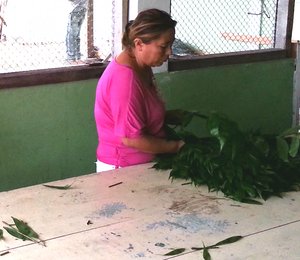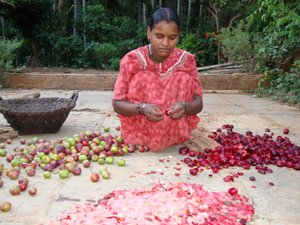Enhancing benefits for smallholders across biodiverse value chains

In conversation with Dietmar Stoian, Principal Scientist, Value Chains and Private Sector Engagement, on why supporting smallholders in business organization and development in diverse value chains for agricultural and tree products is an essential driver of sustainable development.
In conversation with Dietmar Stoian, Principal Scientist, Value Chains and Private Sector Engagement, talking about why supporting smallholders in business organization and development for successful integration into diverse value chains of agricultural and tree products, is an essential driver of sustainable development.
Q: What is your research area at Bioversity International?

A: Together with my colleagues I investigate opportunities for smallholders in developing countries to reap the benefits of producing, processing and marketing diverse agricultural and tree products. Integrating the different stages of the value chain across a diverse portfolio of food and non-food products in domestic and international markets allows farming households and their business organizations to limit risk and respond to seasonal fluctuations of supply and demand.
We know that resource-poor smallholders carefully balance their subsistence needs with those for income generation. Our 'multi-chain approach' therefore accounts for livelihood and business options across a portfolio of agri-food and tree product value chains. In addition, diversity in both production and marketing systems helps improve the provision of environmental services, such as soil and water conservation, pollination, and natural pest control. We are also finding increasing evidence that gender and inter-generational equity is best achieved by working on multiple, market and non-market oriented livelihood activities, rather than focusing only on those geared to a given value chain.
Q: What are the incentives for farmers to diversify production?
A: One incentive is to mitigate production risks and respond to seasonal fluctuations. Additionally, farmers can benefit through improved market outlets and business relationships with buyers of diverse agri-food and tree products. We support farmers and their business organizations – often cooperatives or associations – to identify options for ‘win win’ relationships inside and outside of multiple value chains. This allows farmers to obtain favourable prices and improved access to technical, business and financial services, while their business partners can source quality raw materials or semi-finished products. For this to work, we need to look at all relevant actors along the value chain (buyers, food processors, wholesalers, retailers, etc.) as well as the service providers working outside of the chain – and across a portfolio of various value chains in a given territory.
While this raises the level of complexity, it also enables synergies. For example, working with local governments and private sector companies can lead to improvements in basic infrastructure and logistics. Think of public-private investments in a cold chain which benefit the storage and handling of multiple food products. This increases the quality of food available in local and national markets while at the same time reducing food waste. This, in turn, brings down costs in the value chain – a precondition for providing diverse food to low-income consumers in urban and peri-urban areas of developing countries and ensuring attractive prices for producers.
Further solutions include involving smallholder business organizations in food processing. This enables an increase in the shelf life, value addition and value chain options for perishable products, such as fruits and vegetables. Further options exist for nutrient-rich, non-perishable products such as honey, nuts and pulses. The bottom line is to pursue a truly integrated approach working with diverse value chain actors from producers to consumers, regulatory and sustainability standards bodies, and governmental and non-governmental service providers.
Q: Can you give an example of where this is really working on the ground?
A: We are working at the moment in Guatemala and Nicaragua, with support from the Austrian government and the CGIAR Research Program on Forest, Trees and Agroforestry*, in a project that brings together five complementary research components - value chains, tree genetic diversity, forest policy and governance, sustainable forest management and socio-institutional aspects.
 In addition to timber, we are investigating livelihood and value chain options related to non-timber forest products. These include Xate, a palm whose leaves are used in floral arrangements, and Ramon whose nutrient-rich nuts are ground into flour that local women groups process into tasty and nutritious cookies. By looking into multiple value chains we have been able to identify diverse income generating opportunities in line with the different needs and realities of women, men and the youth.
In addition to timber, we are investigating livelihood and value chain options related to non-timber forest products. These include Xate, a palm whose leaves are used in floral arrangements, and Ramon whose nutrient-rich nuts are ground into flour that local women groups process into tasty and nutritious cookies. By looking into multiple value chains we have been able to identify diverse income generating opportunities in line with the different needs and realities of women, men and the youth.
What is really important to consider is that smallholders need to be 'value chain ready' before they can successfully integrate into value chains. This requires an integrated approach that accounts for the diversified livelihoods of smallholders and their varying asset endowments. For example, you need to ensure they have sufficient resources (labour, land, equipment, capital, time, etc.) to effectively participate in value chain development. If too resource-constrained, non-market interventions may be needed – including state-borne social protection programmes with cash and in-kind transfers. We also need to look at the household and at the farm to monitor if increased marketing of certain crops and varieties leads to undue trade-offs in terms of crop diversity and unwanted shifts in gender-specific laboor division, income generation, and decision–making.
We are now applying our multi-chain approach to eight rural-urban food systems in Africa, Asia and Latin America to improve food and nutrition security of low-income households in urban and peri-urban areas, as well as the livelihoods of rural producers supplying them with quality food.
Q: So value chains are a framework to address poverty?
A: They are, but not in isolation. For example, the nutritional status of smallholder households can be improved by working directly in value chains of nutrient-rich agri-food products, or by increasing income from other value chain activities which can be reinvested in improved nutrition. At the same time we need to be mindful of trade-offs between market and non-market livelihood activities. These may occur when agricultural production is primarily geared to the market, rather than satisfying basic household food needs. Our multi-chain approach helps identify opportunities for building critical livelihood and business assets at the level of smallholder households and business organizations and we find increasing evidence that such two-pronged asset building helps minimize trade-offs and increase food and nutrition security and overall livelihood resilience. After all, you can pursue multiple goals with such an approach.
Q: How important is it to take a gender perspective when trying to overcome barriers in the value chain?
 A: It is absolutely critical. Women, for example, are often the main decision-makers about what to eat at home or what to buy at the market, while men often make decisions in relation to the marketing of agricultural and tree products.
A: It is absolutely critical. Women, for example, are often the main decision-makers about what to eat at home or what to buy at the market, while men often make decisions in relation to the marketing of agricultural and tree products.
Access to, and control over, household resources or assets is a key parameter of our analyses. We seek to identify assets primarily managed by women, those primarily managed by men, and those that are jointly managed. We also analyze which of these assets are controlled by the parent generation, and what assets younger household members have access to. This allows developing gender- and age-differentiated strategies for asset building at the level of individuals, households, and smallholder business organizations. Accounting for the gender and youth dimensions is crucial when developing long-term strategies for the development of livelihoods based on agricultural and tree biodiversity.
This helps us respond to questions like: do the younger household members see themselves as continuing farming or, because of improved access to education in rural areas, are they going to seek employment and income opportunities other than agriculture? In fact, these options are not mutually exclusive. For example, younger household members may take advantage of improved access to information and communication technologies and, based on these, engage in agribusiness or service-oriented activities around the production, processing and marketing of agricultural and tree crops. Business opportunities for women, on the other hand, may be considered culturally appropriate in certain settings if they can be realized close to the homestead. At the same time, we support adaptations of social and cultural norms that permit women fully equitable access to business assets and opportunities along the whole value chain. There are a lot of layers of complexity to consider which is why working at the individual, household, community and territorial levels is so important.
What are the priority research areas for 2016?
In addition to our ongoing work, we are putting together an exciting large-scale development-focused research idea that seeks to improve the diets of 2.3 million low-income consumers and the economic benefits of a variety of value chain actors in eight rural-urban food systems in developing countries. We have selected food systems in three large cities (Hanoi, Managua and Guatemala City) and five small to medium-size towns in Africa and Asia. Our principal goal is to improve the availability of and the access to nutrient-rich, sustainable and affordable foods among low-income consumers – and to provide economic incentives to resource-poor farmers for their production. Towards this end, we will apply a combined whole diet and multi-chain approach, and collaborate with diverse actors from public and private sector, and civil society.
For more information, please contact:
Dietmar Stoian
This work contributes to Bioversity International's Healthy Diets from Sustainable Food Systems Initiative
*This project is a collaborative effort working with CATIE, the University of Vienna, and local partners, with Bioversity International leading on the genetic diversity component (focus on mahogany) and the value chain component.
Photo top: Young woman processing shea nuts. Credit: Bioversity International/B. Vinceti
Photo middle: Xate, a palm whose leaves are used in floral arrangements, is an important source of income in Guatemala and Nicaragua. Credit: Bioversity International/D. Stoian
Photo bottom: Young Indian woman processing Garcinia indica fruit. Credit: Bioversity International/N.Hegde
